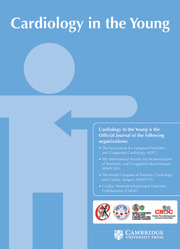No CrossRef data available.
Article contents
Predictive utility of cardiac index-systemic vascular resistance plot and perfusion pressure in late post-Fontan patients
Published online by Cambridge University Press: 03 February 2025
Abstract
Cases of Fontan failure with normal Fontan pressure have been reported. This study aimed to identify catheterisation-derived haemodynamic predictors of heart transplantation/death, other than Fontan pressure, in late post-Fontan patients.
This retrospective study evaluated post-Fontan patients who underwent cardiac catheterisation at age ≥10 years between 1993 and 2018. The predictive effect of cardiac index-systemic vascular resistance index plot and perfusion pressure on freedom from the primary outcome (heart transplantation/death) was evaluated. Patients were categorised into haemodynamic categories A (cardiac index ≥ 3, systemic vascular resistance index ≥ 13), B (cardiac index < 3, systemic vascular resistance index ≥ 13), C (cardiac index ≥ 3, systemic vascular resistance index < 13), and D (cardiac index < 3, systemic vascular resistance index < 13).
In total, 79 patients (median age: 15.7 [range: 10.1–50.2] years) were included; of them, the primary endpoint occurred in 10 (13%; median follow-up: 1.9 [range: 0.1–18.8] years). Category C patients had significantly shorter freedom from the endpoint than categories A and B patients. Univariate analysis identified significant haemodynamic predictors, including Fontan pressure, pulmonary/systemic vascular resistance index, pulmonary/systemic flow, systemic arterial oxygen saturation, systemic venous oxygen saturation, systemic vascular resistance index, perfusion pressure, perfusion pressure < 53 mmHg, and category C. In multivariable analysis, perfusion pressure < 53 mmHg and category C emerged as predictors of heart transplantation/death alongside Fontan pressure.
Haemodynamic profiling of late post-Fontan patients using the cardiac index-systemic vascular resistance index plot can aid to comprehend the post-Fontan status and predict clinical prognosis.
Keywords
- Type
- Original Article
- Information
- Copyright
- © The Author(s), 2025. Published by Cambridge University Press



